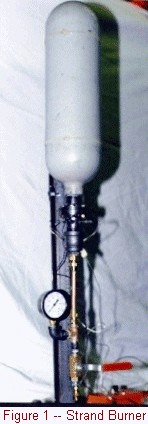IntroductionThe Strand Burner (sometimes referred to as the Crawford Strand Burner) is an apparatus that provides for burn rate measurements of a solid rocket propellant in an environment of elevated pressure. The propellant sample being tested, referred to as a strand, is burned within the confines of a pressure tank, called a Firing Vessel. The strand is in the form of a pencil-like stick, and is electrically ignited at one end. The time duration for the strand to burn along its length (cigarette fashion) is measured. Various means are used to measure the time duration, such as lead wires embedded in the strand which melt when contacted by the flame front, or by use of thermocouples. The burn rate is obtained by knowing the burning distance as well as the burning time between the lead wires (or thermocouples).To effectively characterize the burn rate versus pressure relationship for a particular propellant, 10 or more tests may be performed, at pressures ranging from a few atmospheres, to 100 atmospheres (1500 psi) or more. Nitrogen is normally used to pressurize the firing vessel.This web page describes a Strand Burner that was built primarily for burn rate characterization of the KN/Sugar propellants. Future use of this Strand Burner will be for evaluating, and eventual characterization, of some new experimental propellants. Apparatus
Measurement of pressure within the Firing Vessel was made with the use of a standard bourdon-type pressure gauge. For low pressure measurements, a precision 0-300 psi gauge was used, and for high pressure measurements, a precision 0-5000 psi gauge was used. For data acquisition, the three thermocouples were connected to a Digital Volt Meter, which was interfaced to a 286 PC (details). A software routine was written which sampled the DVM output emf at the rate of 3.3 samples per second. This data was stored in RAM, then written to a text file for permanent storage. 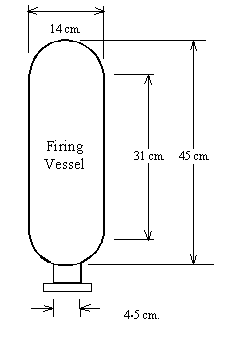 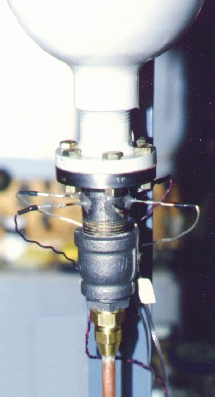  |

Diagram of Strand Holder showing dimensions
Propellant StrandsPropellant strands of the KN/Sugar propellants were prepared by extruding the melted slurry into long "sticks". An extrusion tool was fabricated to facilitate this process. The tool was preheated prior to loading with propellant.The "raw" extruded strands were typically 10-20 cm. long and had an approximately oval cross section of roughly 4x6 mm. These were then inspected for flaws (such as bubbles or discontinuities) with flawed portions being trimmed accordingly. Inspection was done visually by holding the strands up to a strong light. After this step, the strands were cleaned with lacquer thinner, then painted with two coats of hi-heat aluminum paint as an inhibitor. The sides of the strands were usually inhibited along their whole length to ensure that burning only occurred perpendicular to the surface. The final step was cutting to length, with the typical trimmed length being 5-10 cm. The longer strands were used for the higher pressure tests. A photo of painted strands is shown in Figure 6. 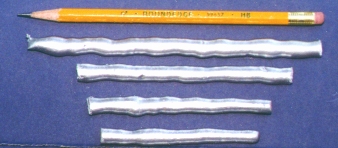 Analysis of DataFor analysis, the thermocouple output data was imported into an Excel spreadsheet and plotted in the form of a line graph, an example of which is illustrated in Figure 7. Acceptable results would be in the form of two pressure spikes, which represent the flame front reaching the first, then second thermocouple. The time period between initiation of the spikes was taken as the time duration required to burn the gauge length of the strand. The data point at which the slope of the curve sharply increased, at each spike, was taken as the reference point defining the time period. In the example plot in Figure 7, the beginning data points are #24 and #64.Combustion of a strand results in a pressure rise, typically of 50 to 100 psi, depending on the strand size (longer strands were used for higher pressures due to more rapid burn rate). This represents about 10% of the nominal pressure. The pressure at which burning was considered to occur (reference pressure) was taken as the average of the initial and maximum pressure. Burn rate at the reference pressure was taken as the gauge length divided by the burn time. A graph showing final results of burn rate measurements for the KN-Sugar propellants is shown in Figure 8. A more complete discussion of these results is provided in the KN-Dextrose & KN-Sorbitol Propellants -- Burn Rate Experimentation web page. 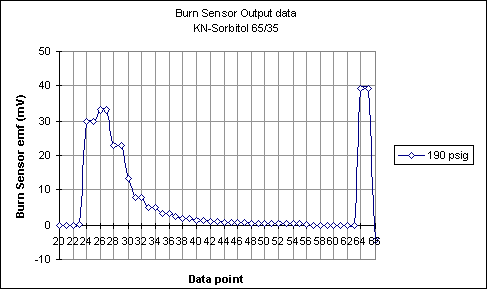  |

